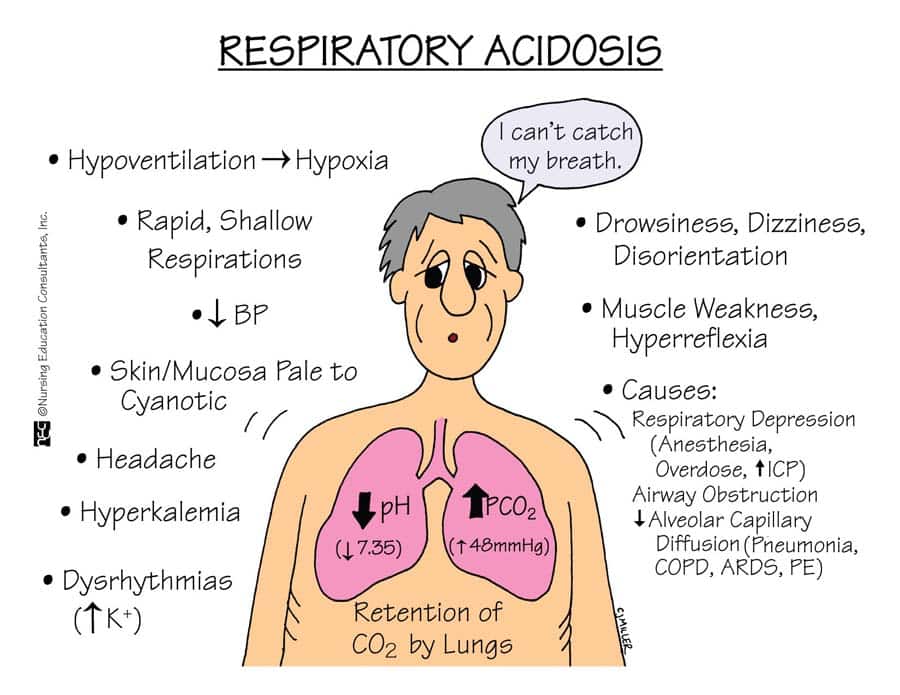Respiratory acidosis is a critical acid-base imbalance that demands vigilant monitoring and prompt nursing interventions. As a common occurrence in various clinical conditions, understanding the underlying pathophysiology, recognizing clinical manifestations, and implementing effective nursing care are paramount to improve patient outcomes. This article aims to provide nurses with a comprehensive overview of respiratory acidosis, empowering them to confidently assess, manage, and support patients afflicted by this complex disorder.
Table of Contents
- What is Respiratory Acidosis?
- Causes
- Complications
- Signs and Symptoms
- Assessment
- Diagnostic Studies
- Nursing Diagnosis
- Nursing Priorities
- Discharge Goals
- Care Setting
- Nursing Care Plans
- Nursing Interventions & Considerations
- See Also
What is Respiratory Acidosis?
Respiratory Acidosis is an acid-base imbalance characterized by increased partial pressure of arterial carbon dioxide and decreased blood pH. The prognosis depends on the severity of the underlying disturbance as well as the patient’s general clinical condition.
Compensatory mechanisms include (1) an increased respiratory rate; (2) hemoglobin (Hb) buffering, forming bicarbonate ions and deoxygenated Hb; and (3) increased renal ammonia acid excretions with reabsorption of bicarbonate.
Acute respiratory acidosis: Associated with acute pulmonary edema, aspiration of foreign body, overdose of sedatives/barbiturate poisoning, smoke inhalation, acute laryngospasm, hemothorax/pneumothorax, atelectasis, adult respiratory distress syndrome (ARDS), anesthesia/surgery, mechanical ventilators, excessive CO2 intake (e.g., use of rebreathing mask, cerebral vascular accident [CVA] therapy), Pickwickian syndrome.
Chronic respiratory acidosis: Associated with emphysema, asthma, bronchiectasis; neuromuscular disorders (such as Guillain-Barré syndrome and myasthenia gravis); botulism; spinal cord injuries.
Causes
- Chronic obstructive respiratory disorders: emphysema, chronic bronchitis
- Chest wall trauma
- Pulmonary edema
- Atelectasis
- Pneumothorax
- Drug Overdose
- Pneumonia
- Guillain-Barre syndrome
Complications
- Shock
- Cardiac Arrest
Signs and Symptoms
- CNS disturbances: restlessness, confusion, and apprehension to somnolence with fine flapping tremor, or coma.
- Headache
- Dyspnea
- Tachypnea
- Increase in blood pressure
- Mental cloudiness and feeling of fullness in head
- Weakness
Assessment
Assessment cues are dependent on underlying cause.
ACTIVITY/REST
- May report: Fatigue, mild to profound
- May exhibit: Generalized weakness, ataxia/staggering, loss of coordination (chronic), to stupor
CIRCULATION
- May exhibit: Low BP/hypotension with bounding pulses, pinkish color, warm skin (reflects vasodilation of severe acidosis)
- Tachycardia, irregular pulse (other/various dysrhythmias)
- Diaphoresis, pallor, and cyanosis (late stage)
FOOD/FLUID
NEUROSENSORY
- May report: Feeling of fullness in head (acute—associated with vasodilation)
- Headache, dizziness, visual disturbances
- May exhibit: Confusion, apprehension, agitation, restlessness, somnolence; coma (acute)
- Tremors, decreased reflexes (severe)
RESPIRATION
- May report: Shortness of breath; dyspnea with exertion
- May exhibit: Respiratory rate dependent on underlying cause, i.e., decreased in respiratory center depression/
- muscle paralysis; otherwise rate is rapid/shallow
- Increased respiratory effort with nasal flaring/yawning, use of neck and upper body muscles
- Decreased respiratory rate/hypoventilation (associated with decreased function of respiratory center as in head trauma, oversedation, general anesthesia, metabolic alkalosis)
- Adventitious breath sounds (crackles, wheezes); stridor, crowing
TEACHING/LEARNING
- Refer to specific plans of care reflecting individual predisposing/contributing factors.
Diagnostic Studies
- CONFIRMING DIAGNOSIS: Arterial blood gas (ABG) analysis of
- PaCO2 higher than 45 mm Hg
- pH is below normal range of 7.35 to 7.45
- bicarbonate level is normal (acute) or elevate (in chronic stages)
- Chest X-ray, CT scan can help determine the cause
- ABGs: Pao2: Normal or may be low. Oxygen saturation (Sao2) decreased.
- Paco2: Increased, greater than 45 mm Hg (primary acidosis).
- Bicarbonate (HCO3): Normal or increased, greater than 26 mEq/L (compensated/chronic stage).
- Arterial pH: Decreased, less than 7.35.
- Electrolytes: Serum potassium: Typically increased.
- Serum chloride: Decreased.
- Serum calcium: Increased.
- Lactic acid: May be elevated.
- Urinalysis: Urine pH decreased.
- Other screening tests: As indicated by underlying illness/condition to determine underlying cause.
Nursing Diagnosis
The following are the possible nursing diagnosis for Respiratory Acidosis:
- Impaired Gas Exchange
- Ineffective Breathing Pattern
- Ineffective Tissue Perfusion
- Acute Confusion
- Risk for Injury
Nursing Priorities
- Achieve homeostasis.
- Prevent/minimize complications.
- Provide information about condition/prognosis and treatment needs as appropriate.
Discharge Goals
- Physiological balance restored.
- Free of complications.
- Condition, prognosis, and treatment needs understood.
- Plan in place to meet needs after discharge.
Care Setting
This condition does not occur in isolation, but rather is a complication of a broader health problem/disease or condition for which the severely compromised patient requires admission to a medical-surgical or subacute unit.
Nursing Care Plans
Main Article: Respiratory Acidosis Nursing Care Plan
Nursing Interventions & Considerations
- Remain alert for critical changes in patient’s respiratory, CNS and cardiovascular functions. Report such changes as well as any variations in ABG values or electrolyte status immediately.
- Maintain adequate hydration.
- Maintain patent airway and provide humidification if acidosis requires mechanical ventilation. Perform tracheal suctioning frequently and vigorous chest physiotherapy, if ordered.
- Institute safety measures and assist patient with positioning.
- Continuously monitor arterial blood gases.


all these info helping me a lot
Hi JO, That’s great to hear! Respiratory acidosis is a complex topic, so I’m thrilled the study guide is proving helpful for you. If you have any questions or need more insights, just let me know. Keep up the great work!
Thank you so much this helped me with my system disorder sheets.
Hi Sinia, You’re welcome! I’m really glad to hear the information on respiratory acidosis was helpful for your system disorder sheets. If there’s anything else you need or more topics you’re curious about, just let me know. Always here to help out!